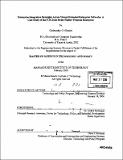| dc.contributor.advisor | Kirkor Bozdogan. | en_US |
| dc.contributor.author | Glazner, Christopher G | en_US |
| dc.contributor.other | Massachusetts Institute of Technology. Technology and Policy Program. | en_US |
| dc.date.accessioned | 2006-11-07T12:38:56Z | |
| dc.date.available | 2006-11-07T12:38:56Z | |
| dc.date.copyright | 2006 | en_US |
| dc.date.issued | 2006 | en_US |
| dc.identifier.uri | http://hdl.handle.net/1721.1/34515 | |
| dc.description | Thesis (S.M.)--Massachusetts Institute of Technology, Engineering Systems Division, Technology and Policy Program, 2006. | en_US |
| dc.description | Page 184 blank. | en_US |
| dc.description | Includes bibliographical references (p. 179-181). | en_US |
| dc.description.abstract | Over the last decade, many companies in industries that produce complex and technologically-advanced products have begun to integrate their operations along the value chains of the primary products they design, produce or sustain. Increasingly, integration efforts have moved beyond the boundaries of the core or focal enterprise serving as the prime contractor or system integrator to span the entire value chain, to form virtual extended enterprises. These structures allow the members of the virtual extended enterprise to focus on their core competencies in order to collaboratively deliver a world-class product at a competitive price. While integration offers many benefits to enterprises, a high degree of integration is not always desirable or advantageous in a limited duration virtual extended enterprise composed of autonomous companies. Virtual extended enterprises must find a balance between decoupled collaboration and highly coupled integration, balancing the need to closely coordinate their efforts with the need protect the autonomy of their members. The objective of this research is to explore the extent to which a focal enterprise, such as a prime contractor or system integrator, should consider integration across its virtual extended enterprise, identify major barriers to integration, and define key enablers of integration overcoming these barriers. | en_US |
| dc.description.abstract | (cont.) Analysis focuses on the extent of integration based on the characteristics of the virtual extended enterprise, such as the duration and scope of the program in question, product system architecture, the organizational architecture, and the external environment. In particular, three key conceptual dimensions of integration are developed and explored-technological integration, strategic integration, and organizational integration. This framework is applied in an in-depth case study of integration strategies on the virtual extended enterprise of the F-35 Joint Strike Fighter (JSF) Program. The knowledge gained from the case study is used to make recommendations for the development of integration strategies for future programs. | en_US |
| dc.description.statementofresponsibility | by Christopher G. Glazner. | en_US |
| dc.format.extent | 184 p. | en_US |
| dc.format.extent | 8847878 bytes | |
| dc.format.extent | 8855606 bytes | |
| dc.format.mimetype | application/pdf | |
| dc.format.mimetype | application/pdf | |
| dc.language.iso | eng | en_US |
| dc.publisher | Massachusetts Institute of Technology | en_US |
| dc.rights | M.I.T. theses are protected by copyright. They may be viewed from this source for any purpose, but reproduction or distribution in any format is prohibited without written permission. See provided URL for inquiries about permission. | en_US |
| dc.rights.uri | http://dspace.mit.edu/handle/1721.1/7582 | |
| dc.subject | Technology and Policy Program. | en_US |
| dc.title | Enterprise integration strategies across virtual extended enterprise networks : a case study of the F-35 Joint Strike Fighter Program enterprise | en_US |
| dc.type | Thesis | en_US |
| dc.description.degree | S.M. | en_US |
| dc.contributor.department | Massachusetts Institute of Technology. Engineering Systems Division | |
| dc.contributor.department | Technology and Policy Program | |
| dc.identifier.oclc | 70892082 | en_US |
